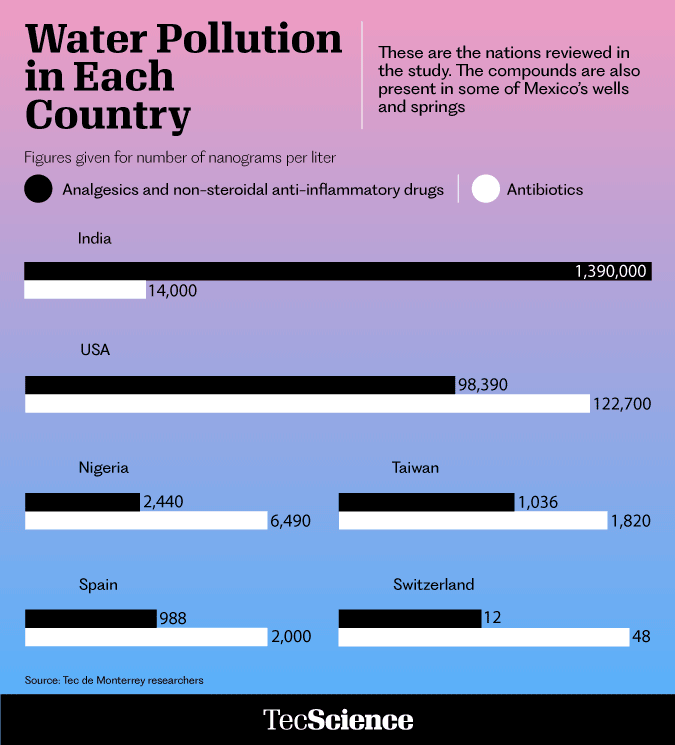We’re ready to go to bed. We head to the bathroom, catch a glimpse of ourselves in the mirror, wash our faces with soap, spit toothpaste into the sink, flash a smile, put on some facial cream, and wash our hands. Little do we realize, this daily routine sends thousands of particles down the drain, transforming into a new threat to the planet’s water.
Classified as pharmaceuticals and personal care products (PPCP), these include antibiotics, soaps, toothpaste, sunscreens, hair products, and their breakdown byproducts.
“We use them indiscriminately, and they’re becoming increasingly prevalent in our lives. The issue is that they accumulate and eventually contaminate water,” explains Jürgen Mahlknecht, a research professor at Tec de Monterrey and leader of the Water Science and Technology group at the School of Engineering and Sciences.
The rise in population and unsustainable resource use led to excessive extraction from surface water sources, forcing a shift to groundwater. Researchers, including Mahlknecht, compiled and integrated hundreds of studies to grasp the global picture, creating a comprehensive database by country and contaminant type for the first time.
They documented evidence, including in Mexico, that populations exposed to high concentrations of PPCP have a higher incidence of certain cancers and an increase in birth defects. For researchers, this analysis isn’t just a scientific endeavor; it’s a call to governments for greater regulations on these substances.

Groundwater Contamination: Antibiotics, Triclosan, and Amphetamines
Efforts to assess groundwater contamination had previously been scattered, focusing on specific pollutants in specific regions.
“We concentrated on studies from 2010 to 2020 to understand the global panorama of PPCP pollution in the second decade of the 21st century,” explains Manish Kumar, head of the sustainability group at the School of Engineering at the University of Petroleum and Energy Studies in Dehradun, India, and a member of the Faculty of Excellence at Tecnológico de Monterrey, elaborated on this in an interview with TecScience.
Both Kumar and Mahlknecht found the situation more severe than anticipated—there isn’t a geographic zone worldwide without traces of these substances in its groundwater. Stimulants like caffeine and amphetamines, antibiotics, and pain relievers like diclofenac and ibuprofen, as well as antiepileptics, antidepressants, and hormones from contraceptives, were among the most common pollutants.
In the United States, antibiotic concentrations reach up to 122,700 nanograms per liter of water, while in India, analgesics, antipyretics, and anti-inflammatories hit 1,390,000 nanograms per milliliter—both considered excessive. Triclosan, an antibacterial in soaps and shampoos, is detected in high concentrations in several countries worldwide.

Challenges in Mexico: Paracetamol and Cocaine Metabolites
While robust research on the impact of these contaminants is lacking in Mexico, various groups contribute to piecing together the puzzle. Understanding the extent of contamination is crucial, as 40% of the Mexican population relies on groundwater for drinking water.
A 2018 study measured harmful substances in groundwater in the Valle del Mezquital, Hidalgo, finding high concentrations of 65 pharmaceutical compounds, including paracetamol and metformin, human hormones, and benzoylecgonine (a cocaine metabolite). In 2021, a study on the contamination of the Atoyac River in Puebla revealed triclosan, naproxen, diclofenac, microplastics, coliform bacteria, and heavy metals.
“It’s the most polluted river I’ve seen in my life. It’s a pollution soup. But that’s not the worst part; this water is used to irrigate the food that the people of Puebla consume,” warns Abrahan Mora, a research professor at Tec de Monterrey, Campus Puebla, who participated in the study.
Increased Cancer Prevalence
Although many health risks associated with emerging contaminants remain unknown, there are hints of the problems they could cause. The most significant may be antibiotic resistance, as untreated groundwater may contain high concentrations of common antibiotics.
Consequences observed in populations affected by PPCP pollution include decreased fertility rates, birth defects, and a higher incidence of colon, breast, and testicular cancers.

Enzymes to Purify Water
Solving the problem will require concerted efforts from scientists, authorities, and society. The first step is identifying areas at a higher risk of accumulating emerging contaminants in groundwater. Mahlknecht and Kumar found that some of the most polluted points are near treatment plants, hospitals, landfills, and pharmaceutical facilities.
In these areas and poorly maintained plants, enhancing water treatment for human use is crucial, adding specific filters for the most abundant contaminants. According to Nancy Ornelas, a research professor at Tec de Monterrey and member of the Water Center, the future lies in using enzymes derived from microorganisms, like bacteria or fungi, capable of degrading all types of substances and leaving water pristine.
“Depending on each organism, everything can be degraded… and producing enzymes is quite inexpensive,” she asserts. Additionally, raising awareness among the public to moderate the use of pharmaceuticals and personal care products is crucial. It’s equally important to reinforce public policies and encourage decision-makers to consider these contaminants in global and local regulations in each country.
Mahlknecht and Kumar’s study was picked up by the European Commission’s news section to alert governments about the growing concern of PPCP groundwater contamination, hoping to lead to new and improved public policies. “We’re excited because our effort wasn’t just for science; it’s to truly be taken into account in future regulations,” Mahlknecht anticipates.







